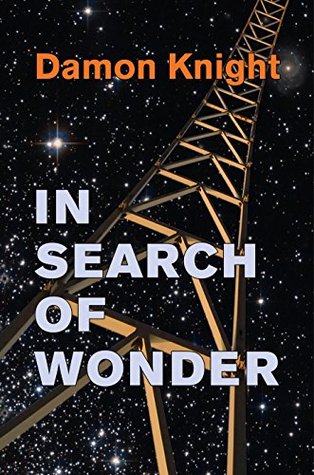Kindle Notes & Highlights
The critic attempts to measure the work by more lasting and more nearly absolute standards, to determine its place, not for the reader of the moment, but for the cultivated mind viewing the entire art of which this work forms a segment.
And (this is the “getting something done”) it provides conclusive proof that, to quote knight’s introductory credo, “science fiction is a field of literature worth taking seriously, and that ordinary critical standards can be meaningfully applied to it.”
The letter went on to enumerate the parts of the Plot Skeleton, viz.: 1) A sympathetic and believable lead character, 2) an urgent and vital problem; 3) complications caused by the lead character’s unsuccessful attempts to solve the problem; 4) the crisis (this element was added by Blish); 5) the solution, brought about by the lead character through his own courage and resourcefulness.
I was trying to pay science fiction the compliment of taking it seriously, something that had never been done in any extended way within the field before. Up to this point, our admiration for science fiction had been indiscriminate; we liked some things more than others, but we liked everything. To criticize science fiction severely would have been to risk allying ourselves with the outside critics who scorned it.
The critical method is to take things apart. The critic uses the same sharp-edged tools on all stories, but good stories resist; bad ones come to pieces.
I think it was my friend Jim Blish who coined the term “idiot plot,” defined as a plot which is kept in motion solely by virtue of the fact that everybody involved is an idiot.
In general, van Vogt seems to me to fail consistently as a writer in these elementary ways: 1. His plots do not bear examination. 2. His choice of words and his sentence-structure are fumbling and insensitive. 3. He is unable either to visualize a scene or to make a character seem real.
Now by God, this is science fiction. It performs s.f.’s specific function, to lift us out of the here-and-now and show us marvels. No matter how badly it’s written, if a story does that it is s.f. A story that fails to do that, no matter how well written, isn’t.
The people he writes about are healthy, uninhibited and positive, a totally different breed from the neurasthenic heroes of many of his colleagues. In a field whose most brilliant and well-established writers seem to flip sooner or later, Heinlein is preeminently sane.
However, I’ve done my best to overcome this lack; I have collected every adverse criticism of Heinlein I could find. So far I have two: (1) His plots are weak. (2) He uses slang.
Except for a few Greek philosophers, nobody believed that planets of other stars were inhabited until a few centuries ago. Nowadays many people believe it, and therefore it is true; and consequently we have dreamed something into existence which limits our power to dream.
in this case, what William Atheling, Jr., calls van Vogt’s “intensively recomplicated” story. My own term is simpler; I call it the Kitchen Sink Technique. Briefly, this consists of packing as much as possible of everything into a given space. I mean almost everything: plot, incident, background, allusion, confusion; character usually gets left out.
Dazzlement and enchantment are Bester’s methods. His stories never stand still a moment; they’re forever tilting into motion, veering, doubling back, firing off rockets to distract you.
my point is that reality alone does not justify putting anything into a story: Fiction is reality plus meaning.
“Nothing remains interesting where anything may happen.”)
Science fiction and prophecy are two different things.
In a recent novel I suggested that by the year 2000 science fiction will have become the dominant form of literature:
It is one of the accepted conventions of the genre that the author is to be allowed one fantastic assumption;
To young writers, three admonitions: love your work; read your contracts; make friends when you can.


